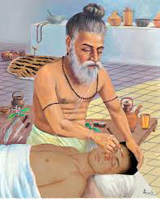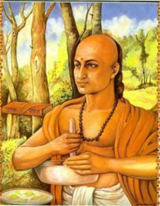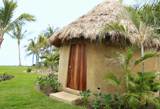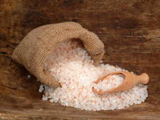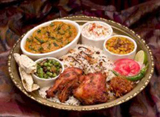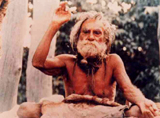Ayurveda
A review of kutīpraveśikā rasāyana
Abstract
Rasāyana therapy plays an important role in maintaining and promoting positive health by promoting the body’s resilence, i.e. giving ‘immunity’ against disease. With the help of rasāyana therapy, prevention and cure of diseases is possible. In this article, a historical review of types of rasāyana therapy with information regarding kutīpraveśikā is given.
Introduction
Over the past few decades, there is a change in lifestyle as more and more people climb to a higher socio-economic status. People are eating more fat, carbohydrate, animal proteins as well as preserved canned food. Physical activity has decreased due to availability of cars, buses etc. In addition, stress has become common in daily life. The urban lifestyle adopted for personal comfort, enjoyment and happiness is proving haz-ardous and hastens early ageing.
Āyurveda, the ‘science of life’, has two objectives:
1. To maintain and promote positive health.
2. To cure disease.
In the Indian tradition, puruṣārtha catuṣṭaya, i.e. the four cherished desires of man are: dharma (right living), artha (prosperity), kāma (sensual joys) and mokṣa (freedom from bondage of desires). To attain them, a long and healthy life is essential. With rasāyana therapy comes prāṇaiṣaṇā (ease of prāṇa or life-force), dhanaissannā (ease of wealth) and paralokaissaṇā (ease of connection to the spirit worlds) (2).
Prāṇaiṣaṇā i.e. ease of prāṇa is primary because the other two can be achieved only if prāṇa persists. Ācārya Caraka (3) has aptly said in Sūtrasthāna that,
”With the ending of life, all ends” (p. 68).
Long life can be achieved by following the rules for healthy living and by prompt attention to the treatment of diseases if they occur.
In Āyurveda, importance is given to svāsthya-pālana (healthy living) (4). An individual is said to be svastha or healthy when the doṣas (humors), dhātus (elements), malas (excretions) and agni (fire) are functioning normally creating a tranquillity of mind, soul, sensory as well as motor organs (5).
Dhātusāmyatā (a balance of all dhātus) can be secured by cikitsā (treatment) (6). This is classified into bheṣaja (with medicine) and abheṣaja (non-medicinal). Under the category of treatments improving vitality (svasthasya ūrjaskara) the bheṣaja type is sub-classified into rasayāna and vājīkaraṇa (7). These two methods chiefly improve the life-force.
Rasāyana or jarā cikitsā is one of the eight branches of Āyurveda practised extensively and effectively for a long time. Though chiefly concerned with improving a person’s youthfulness and lifespan, rasāyana is also used as an effective treatment.
Etymology of rasayāna
The word rasayāna consists of two parts:
1. Rasa – in the present context of rasāyana, the word ‘rasa’ is used in the sense of the end-products of digestion.
2. Ayana – In the present context of rasāyana, the word ‘ayana’ means the attainment of good quality of ‘rasa’.
Nirukti (derivation) of rasayāna
Rasa is in reference to rasa-raktādi dhātus. The means of purifying rasa-raktādi dhātus (elements of the blood and digestive processes) is termed as rasāyana (8).
Dalhana opines that rasāyana is the one in
which digested food juice (rasanam) nourishes the rakta dhātu (9).
What is rasāyana?
Dalhana further adds that rasāyana stabilises youthfulness and prolongs life with activities through its rasa, vīrya etc. (10).
Arundatta states that rasāyana is one by which rasa, raktādi dhātus benefit through proper nourishment. The Kairali commentary of Aṣṭaṅga Hṛdaya defines rasāyana as one that transforms dhātus from rasa to śukra (11).
The one which cures jarā (age) and vyādhi (illness); stabilises youthfulness; increases acuity of cakṣu (vision), indriyas (senses), etc.; nourishes the whole body; and is an aphrodisiac is known as rasāyana.
Gangadhara while commenting on Kairali says that rasāyana is one which causes continuous nourishment to rasa, dhātus, etc., thereby replenishing them (12).
Ācārya Caraka simply defines rasāyana as the means by which one gets excellence of rasa, dhātus, etc. Psychic excellence such as a sharp memory, etc. are also endowed by this treatment, asserts Cakrapāṇi.
Classification of rasāyana tantra
Rasāyana tantra is one of the clinical disciplines of Aṣtāṅga Āyurveda. (Eight-fold Āyurveda).
Two types of procedures have been mentioned in rasāyana tantra:
(i) Kutīpraveśikā
(ii) Vātatapikā (13)
Kutīpraveśikā (meaning literally, entering a hut) is one where rasāyana is given with the person staying inside a closed kutī (cottage) whereas vātatāpikā is where rasāyana is administered with the patient exposed to vāta and aṭāpa (the elements). In other words, Kutīpraveśikā is an indoor procedure, while vātatāpikā is an outdoor administration of rasāyana.
kutīpraveśikā rasāyana
It has three steps — pūrva, pradhāna and paścāt karma (14).
I. Pūrva Karma
Kutī nirmāṇa (Building the cottage)
A specially built trigarbha kutī, is constructed in a beautiful, peaceful location free from dangers, where the required appliances can easily be procured.
This cottage should face east or north. It should be spacious and have a high roof. It should have three concentric units furnished with narrow ventilators. Its walls should be thick and it should be pleasant to reside in, in all seasons. It should be well-lit and pleasing to the mind, free from undesirable noise, etc. It should be equipped with every required equipment for rasāyana treatment. Physicians, medicines and brahmins should also be readily available here (15).
Collection of useful material
Materials like beds, āsana (sitting mats), saṃśodhana dravya, rasāyana drugs, emergency drugs and medicines to treat complications, if any, should be collected and kept in the cottage (16).
Selection of rasāyana drugs
Rasāyana drugs are selected according to the age, individual constitution, adaptability, digestive capacity, metabolic status and the state of body tissues. Āyurveda advocates the use of different rasāyana drugs for persons of different age-groups and different constitutions.
Preparation of the patient
A. Yogya-ayogya vicāra (Indications of treat-ment)
1. Rasāyana therapy for ageing should be administered to those of early to middle-age (17).
2. To those who have undergone oleation, blood-letting and purification therapies.
3. To those free of all encumbrances and who can afford it.
B. Rasāyana sevana yogya kāla (Time of treatment)
A suitable kāla (time) for carrying out the rasāyana therapy is also described by Ācāryas (wise teachers). The śarata (autumn), vasanta (spring), and prāvṛṭ (rainy) ṛtu (seasons) are supposed to be the best periods for administration of rasāyana therapy because these ṛtus provide samaśītoṣṇa kāla, i.e. a period neither too hot nor too cold (18).
C. Mātrā nirdhāraṇa (dose assessment)
Ācārya Caraka has emphasised that the dosage of the rasāyana drug should be decided according to the agnibala (strength) of the patient. He further clarifies that a dosage not interfering with the patient’s routine diet is ideal. Arunadutta has emphasised that a patient’s nocturnal diet (dinner) should not be disturbed by his intake of rasāyana drugs (19).
Others are of the opinion that the rasāyana drugs should be administered in the morning in such an amount which can be digested by lunchtime. But in case of vardhamāna rasāyana, similar doses of the rasāyana drug can be administered to different types of people, e.g. pippalī vardhamāna rasāyana.
D. Rules for kutī praveśa (entering the cottage)
1. A person wanting rejuvenation therapy should enter the cottage on an auspicious day with an auspicious nakṣatra* and favoured muhūrta (auspicious time) during the uttarāyaṇa (sun’s northern course i.e., from about 14 January to 16 July) in the lighted half of the month (śukla pakṣa) (20).
2. The person should enter the cottage shaved, endowed with perseverance and good memory, full of faith, single-minded, having removed all afflictions, cherishing goodwill for all living beings, and having worshipped the gods and brahmins.
E. Saṁśodhana (purification) yoga
Before administration of rasāyana therapy, one has to undergo an appropriate Saṁśodhana-karma (purification therapy) for perfect and adequate rasāyana effects.
One who has undergone snehana (oleation therapy) and svedana (fomentation) therapies earlier should drink hot water to which the paste of harītakī, āmalakī, saindhava salt, śuṇṭhi, vacā, haridrā, pippalī and guḍā (jaggery) has been added. By consuming this preparation, he defecates easily (21).
F. Saṁsarjana karma
Saṁsarjana karma constitutes the primary post-treatment procedure for digestion. This term literally means a ‘graded administration of diet’. It consists of a specially prepared diet designed to re-establish full digestive capacity and prevent the formation of new āma (undigested material).
One who has thus been purified and has followed the saṁsarjana karma — for three days (avara satva), five days (madhyama satva) or seven days (uttama satva) — till his faeces get purified (22) should begin to consume the prescribed rasāyana treatment.
II. Pradhāna karma
After proper purification, when the patient is well and has regained his strength, the person enters the kutī where the rasāyana is administered.
Suśruta has indicated that the patient should remain in the trigarbha kutī for one month. During the first ten days, the patient should stay in the innermost kutī. He slowly moves outwards as his inner environment becomes favourable to the external environment. It is very important to stabilise the internal environment of the body when the patient leaves the kutī.
Ācārya Caraka and Vāgabhatta have given a specific list of rasāyana preparations which are to be administered for getting the best results. These include:
1. Brahma rasāyana (23).
2. Harītakyādi rasāyana (24).
3. Āmalakī rasāyana (25).
4. Cyavanprāśa rasāyana (26).
If, during the therapy, complications arise due to faulty methods, then the proper respective treatment is to be provided to the patient and the rasāyana course stopped. (27)
III. Paścāt karma
The patient should follow the instructions of the treating physician after the completion of rasāyana therapy for āhāra (diet), vihāra (lifestyle) and ācāra (behaviour), as described below:
Āhāra (diet)
Ācārya Caraka has advised taking specific pathya after the administration of rasāyana therapy, i.e. śāliṣaṣṭikānna,(28) with ghee, milk and ajā dugdha (goat’s milk) (29) and sātvic āhāra. The patient should be allowed to return to a normal diet after double the time of the rasāyana sevana kāla (parihāra kāla) (30). During this period, the patient should remain on laghu āhāra, milk or other pathya dravyas, otherwise mandāgni may occur.
Vihāra (lifestyle)
a. The person should avoid exertion.
b. He/she should avoid exposure to direct air, sunlight and cold immediately after the therapy.
c. Mental stress should be avoided (31).
Ācāra (behaviour)
A positive attitude plays a very important role. The following three things are necessary for obtaining best results from the therapy (32).
1. Personal behaviourĀcārya Caraka suggests that one should abstain from alcohol and sex; one should not indulge in violence or over-exertion; be peaceful and pleasing in speech; one’s waking and sleeping times should be regular; and one should take sufficient amounts of milk and ghee habitually. One should try to avoid ego.
2. Sātvika behaviour
Ācāryas have recommended that one should practice japa (chanting) and cleanliness. One should become stable and steady (dhīra) of mind. One should regularly practise charity and penance (tapa). One should have love for spiritual knowledge. One should have reverence for elders, those who believe in God and people with self-control. One should regularly study the scriptures and study oneself.
3. Social behaviour
Ācāryas have suggested that one should give donations and be sympathetic to others. One should regularly offer sevā to gods, cows, brahmins, teachers, preceptors and old people. One should remain absolutely free from barbarous acts. One should be broad-minded, having knowledge of deśa (place), kāla (time), pramāṇa (measure) and yukti (resources).
IV. Nisskramanna vidhi (coming out of the kutī)
No specific description is available in Caraka saṁhitā about niṣkramaṇa vidhi, but Ācārya Suśruta has described it as follows:
Following the same principles as noted for the time of entering the cottage, the patient is instructed to come out of the trigarbha kutī — a specially good time is during pūrṇimā i.e. full moon (33).
Observation and discussion
Ācāryas have suggested that if a person carries out Kutīpraveśikā rasāyana in a pleasant state of mind he attains longevity, youthfulness, lustrous complexion, strong voice, excellent resilence, good memory and intellect and freedom from disease. Such a person achieves brilliance. What he says comes true, and he is respected.
In clinical practice, it was observed that the Kutīpraveśikā rasāyana is rejected by people due to its duration. In the present era of stress and fast lifestyles, the complete treatment is not possible. The abbreviatetd procedure does not completely arrest ageing but by providing bala (strength) to agni (energy/fire), it improves pācanakriyā (digestive ability) and makes praśasta rasadhātu (healthy fluids) which is the base of healthy rasa dhātu **
Our suggestion is that life is a gift of God which is given only once: so take a break from your busy schedule and make time once in six months, once in a year or once in five years for this purification process in order to enjoy a joyful life with a healthy body and mind.
Conclusion
So in our present era of busy, stressful and sedentary lifestyles, it is important to increase the resilience of the body and mind. This is made possible by rasāyana tantra, which leads to an improvement in the overall well-being, prevents ageing, develops immunity, enhances bodily strength and improves mental faculties.
References
1. Trikamji Ācārya (ed.) Caraka samhitā Sūtrasthāna Ch. 1, Śloka 3. New Delhi: Rastriya Sanskrit Samsasthan; 2006 re-print, p. 6.
2. Ibid. Sūtrasthāna Ch. X1, Śloka 3, p.67.
3. Ibid. Sūtrasthāna Ch. X1 Śloka 4. p.68.
4. Ibid. Sūtrasthāna Ch. X1, Śloka 3, p.67.
5. Trikamji Ācārya. (ed.) Suśruta samhitā. Sūtrasthāna Ch.XV, Śloka 41. 6th ed. Varanasi: Chaukhamba Orientalia; 1997, p. 75.
6. Trikamji Ācārya. Caraka samhitā. Sūtrasthāna, Ch. XVI, Śloka 34. Varanasi: Chaukhamba Orientalia; 1997, p. 98.
7. Ibid. Cikitsāsthāna Ch. I, 1st pada, Śloka 4-6. p. 376.
8. Trikamji Ācārya. (ed.) Caraka samhitā. Cikitsāsthāna Ch. I, 1st pada, Śloka 6. New Delhi: Rastriya Sanskrit Samsasthan, Jalpakalpataru Commentry by Gangādhara, reprint 2006, pg. no. 2264.
9. Trikamji Ācārya. (ed.) Suśruta samhitā. Sūtrasthāna Ch.I, Śloka 7. New Delhi: Rastriya Sanskrit Samsasthān; reprint 1992, Nibandha Samgraha commentary of Dalhana, p.2.
10. Trikamji Ācārya. (ed.) Susruta samhitā. Cikitsāsthāna Ch.XXVII, Śloka 1-2. New Delhi: Rastriya Sanskrit Samsasthan; reprint 1992, Nibandha Samgraha commentary of Dalhana, p. 498.
11. Paradkar HS. (ed.) Asṭāñga hṛdaya, Sarvañga-sundara and Āyurveda rasāyan commentary of Arundutta and Hemadri, Vāgbhata. uttarasthānam. Ch. XXXIX, Śloka 2, 8th ed. Varanasi: Chaukhamba Orientalia; 1998, p. 923.
12. Trikamji Ācārya (ed.) Caraka samhitā. Sūtrasthāna Ch. XXX, Śloka15. New Delhi: Rastriya Sanskrit Samsasthan; Jalpakalpataru Commentry by Gangādhara, 2006 re-print, p. 1171.
13. Trikamji Ācārya (ed.) Caraka samhitā. Cikitsāsthāna Ch.I,1st pada of Śloka 16. New Delhi: Rastriya Sanskrit Samsasthan; Deepika commentary by Cakrapaṇidatta, 2006 re-print, p. 377.
14. Ibid. Cikitsāsthāna Ch.I,1st pada of Śloka 17-22, p. 377.
15. Ibid. Cikitsāsthāna Ch.I,1st pada of Śloka 19, p. 377.
16. Ibid. Cikitsāsthāna Ch.I,1st pada of Śloka 20, p. 377.
17. Trikamji Ācārya. (ed.) Suśruta samhitā. Cikitsāsthāna Ch.XXVII, Śloka 3. New Delhi: Rastriya Sanskrit Samsasthan; reprint 1992, Nibandha Samgraha commentary of Dalhana, p. 499.
18. Trikamji Ācārya (ed.) Caraka samhitā. Cikitsāsthāna Ch.I, 1st pada of Śloka 21. New Delhi: Rastriya Sanskrit Samsasthan; Deepika commentary by Cakrapaṇidatta,, 2006 re-print, p. 377.
19. Ibid. Cikitsāsthāna Ch.I, 1st pada of Śloka 72. p.379.
20. Ibid. Cikitsāsthāna Ch.I, 1st pada of Śloka 21. p. 377.
21. Ibid. Cikitsāsthāna Ch.I, 1st pada of Śloka 25-26. p. 377.
22. Ibid. Cikitsāsthāna Ch.I, 1st pada of Śloka 27-8. p. 377.
23. Ibid. Cikitsāsthāna Ch.I, 1st pada of Śloka 41-57. p. 388.
24. Ibid. Cikitsāsthāna Ch.I, 1st pada of Śloka 76. p. 390.
25. Ibid Cikitsāsthāna Ch.I, 1st pada of Śloka 75. p.390.
26. Ibid. Cikitsāsthāna Ch.I, 1st pada of Śloka 59-69. p.380.
27. Ibid. Cikitsāsthāna Ch.I, 4rth pada of Śloka 29. p. 388.
28. Ibid. Cikitsāsthāna Ch.I, 1st pada of Śloka 58. p. 379.
29. Ibid. Cikitsāsthāna Ch.I, 4rth pada of Śloka 7. p. 387.
30. Ibid. Cikitsāsthāna Ch.I, 1st pada of Śloka 75. p. 380.
31. Trikamji Ācārya. (ed.) Suśruta samhitā. Cikitsāsthāna ChXXIX, Śloka 11. New Delhi: Rastriya Sanskrit Samsasthan; reprint 1992, Nibandha Samgraha commentary of Dalhana, p. 503.
32. Trikamji Ācārya (ed.) Caraka samhitā. Cikit-sāsthāna Ch.I, 4th pada of Śloka 30-35. New Delhi: Rastriya Sanskrit Samsasthan; Deepika commentary by Cakrapaṇidutta,, 2006 re-print, p. 377, p. 389.
33. Trikamji Ācārya. (ed.) Suśruta samhitā. Cikitsāsthāna ChXXIX, Śloka 13. New Delhi: Rastriya Sanskrit Samsasthan; reprint 1992, Nibandha Samgraha commentary of Dalhana, p. 504.
* The nakṣatras are one of the oldest references we have to astrology from the Ṛg Veda, dating back about 5,000 years ago. The nakṣatras are divisions of 13 degrees 20 minutes starting from zero Aries and ending at 30 degrees of Pisces, 13.20 divided into the 12 signs is 27. The nakṣatras are referred to as the lunar mansions because the moon moves approximately 13.20 per day, therefore, resides in one nakṣatra per day. The personal planet in which the nakṣatra resides will reveal deep information about the individual in relation to the meanings of the houses (area of life), and what houses the planet rules.
** The quality of the rasa dhātu is dependent upon the health of agni or digestion. Rasa dhātu is produced from the digestion of food and liquid. Food and liquid are initially digested in the digestive system and according to Āyurvedic theory, turned into ahāra rasa (milky substance similar to chyle). This fluid is then further digested within the śleṣma dhāra kāla by the rasāgni. The health of this fire determines the quality of rasa produced. When the rasāgni is ideal, healthy rasa dhātu is produced along with minimal kapha doṣa. In other words, transformation is efficient and there is little waste product produced. When the rasāgni is low, the efficiency of the transformation is reduced. The quantity of rasa produced is actually greater but it is of poor quality. In addition, excessive waste is produced so kapha doṣa increases. When the rasāgni is too high, it efficiently converts āhāra rasa to rasa dhātu but also burns up some of the rasa dhātu that is being produced. Thus, a smaller amount of rasa dhātu is produced and there is deficiency. There is also minimal waste. Thus, kapha doṣa is reduced. The state of rasāgni is dependent upon jattharāgni - the main digestive fire. If jattharāgni is healthy, so too will be the rasāgni. In order to determine the health of the rasāgni it is necessary to observe the results of digestion — the rasa dhātu. www.ayurvedacollege.com/articles/drhalpern/Rasa%20Dhatuý
Dr. Shinde Ashashri M.D. works in the dept. of Dravyaguna, National Institute of Ayurveda, Jaipur.
Dr. Gahunge Pankaj M.D. works in the dept. of maulik siddhanta, National Institute of Ayurveda, Jaipur.
Dr. Asit Kumar Panja is a lecturer, in the dept. of maulik siddhant, National Institute of Ayurveda, Jaipur.
Dr. Sudipt Kumar Rath is a lecturer, in the dept. of dravyaguna, National Institute of Ayurveda, Jaipur.
Share with us (Comments,contributions,opinions)
When reproducing this feature, please credit NAMAH,and give the byline. Please send us cuttings.

